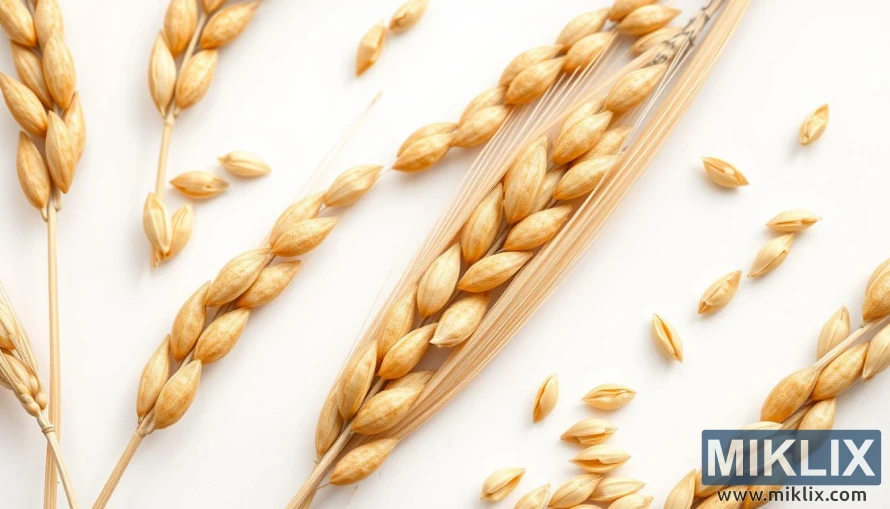Image: Fresh Organic Barley Grains
Published: May 15, 2025 at 11:41:24 AM UTC
Last updated: September 24, 2025 at 8:08:58 PM UTC
Detailed close-up of organic barley grains and stalks under soft natural light, highlighting their golden hues, rich texture, and nutritional benefits.
The image presents a refined and elegant portrayal of barley in its most natural form, captured with a precision that highlights both its simplicity and its enduring importance as one of humanity’s foundational grains. Set against a pure white background, the golden stalks and scattered grains seem to almost float, their warm hues standing out vividly against the pristine backdrop. This minimalist setting strips away distractions, allowing every curve, texture, and sheen of the barley to become the focus. Each stalk is depicted in crisp detail, its kernels tightly clustered along the stem, their protective husks slightly ridged and glowing with a soft luster that suggests freshness and vitality. The interplay of soft natural light across their surfaces enhances these qualities, creating gentle shadows that lend depth without detracting from the barley’s inherent radiance.
The composition is thoughtfully balanced, with intact stalks laid diagonally across the frame and individual grains scattered around them, as though some kernels had naturally slipped free, emphasizing both abundance and variety. The grains themselves, small yet robust, shimmer in golden tones ranging from pale straw to deeper amber, evoking images of sunlit fields swaying under a late summer sky. Their arrangement evokes both order and organic spontaneity, capturing the sense that barley is as much a work of art from nature as it is a practical staple of human diets.
What emerges from this visual is not merely an agricultural product but a symbol of nourishment that has sustained civilizations for millennia. Barley’s significance extends far beyond its aesthetic appeal—it is a grain celebrated for its resilience, able to thrive in diverse climates, and for its versatility, finding its way into breads, porridges, soups, and even beverages such as beer. Nutritionally, it is a powerhouse of fiber, particularly beta-glucan, which is known for supporting heart health and regulating cholesterol. It also contains proteins, essential minerals like magnesium and selenium, and a variety of antioxidants, making it an enduring ally in promoting wellness. By isolating the barley on a stark white background, the photograph draws attention not only to its form but also to the layers of meaning it carries: sustenance, tradition, and vitality.
The clean aesthetic of the image conveys a modern sensibility, resonating with contemporary ideas of healthy living and minimalism. In today’s world, where wellness is often sought through simplicity and authenticity, this presentation of barley embodies exactly that ethos. It suggests that health is not found in complexity or excess but in the pure, unadulterated gifts of nature—grains like barley that have nourished generations through their unassuming strength. The sharp clarity of the photograph reinforces this message, making each kernel a testament to nature’s intricate design and functional beauty.
Ultimately, the image succeeds in transforming barley from a humble agricultural crop into an emblem of health, tradition, and modern wellness. Its golden tones set against the clean white backdrop symbolize a balance between heritage and contemporary life, reminding us that even in an age of innovation, the simplest ingredients remain essential. By focusing so intimately on the barley stalks and grains, the photograph invites the viewer to pause and appreciate the quiet elegance of a food that, though often overlooked, has been woven deeply into the fabric of human existence.
The image is related to: Barley Benefits: From Gut Health to Glowing Skin

